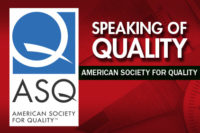Recently I had a conversation with a senior quality engineer at a large manufacturing operation about the future of the quality profession. There is no definite answer because no one has a crystal ball but a transformation has been underway. There have been several studies published and many articles, including some by this author, written on this issue.
Many quality professionals have been engaged the last few years to help with Six Sigma and lean initiatives. Historically, we know that programs evolve after a few years so we continually find ourselves engaged in conversations asking, “What happens after Six Sigma and lean?” Even though lean manufacturing drives companies to many good things, lean, by itself, can’t correct all the problems facing the business world. At least in the near future, the U.S. cannot be lean enough to offset the low-cost labor markets in the Middle East, Africa and other parts of the world.
The problem of market share isn’t entirely due to labor costs. Market share is a combination of cost and value but the broader issue is that of quality. “As delivered quality” (quality delivered to a customer) is certainly important, but long-term reliability may be the primary differentiator for customer retention. It’s not the small percentage of non-conforming components that are found during the manufacturing and assembly processes, but the good parts that fail before the customer is through using them that is causing high levels of dissatisfaction. The problem seems to rest with reliability, which is more related to design. Once the product is in the hands of the end-customer, there is an expectation of uninterrupted usage.
When thinking about this, and related quality issues, I am reminded of something I learned many years ago. As an athlete playing baseball and football our teams didn’t have many outstanding players, but we consistently won against much more talented teams. Why did that happen? We had coaches who were experienced, hardened and wise.
Ted Panish, a member of Bradley University’s Famous Five basketball teams, and Corwin Clatt, a former Chicago Cardinals NFL player in the late 1940s and early ‘50s, were sticklers for details and the fundamentals of their sports. They constantly drilled their teams on the finer points of the sport by making us practice “blocking and tackling” until we could execute those skills in our sleep. They were tough, demanded commitment and excellence, but, in the end, their teams were winners by working together to achieve a common goal.
The way “blocking and tackling” was done in the old days may not be the same way it is today (and the coaching style has definitely changed). It is, however, about knowing what has to be done and performing it with rigor and discipline until results are predictably correct.
How does this relate to the issues of manufacturing quality and where we need to go from here? U.S. businesses must consider a couple things if they are to return to the levels of customer satisfaction that will entice people to purchase their products and services.
The first is to return to the basics, getting back to the rigor of doing the right thing at the right time for the right reason. Many companies continue to overlook this fundamental. Process excellence is about rigor and discipline in execution and not about compromising product integrity.
The second is to strive for strength and quality product and process design, followed by stringent validation of designs before implementation takes place. There are far too many products rushed to market before being fully validated. This causes far too many engineering changes required to correct design issues after the product has been released for manufacturing. These changes drive costs upward, cut profit margins, and have the potential to further compound quality problems.
Business leaders have to give serious consideration to have design engineers be members of American Society for Quality (ASQ), and certify as Quality and Reliability Engineers as well as Six Sigma black belts. The engineers—and their management—need to learn how to use the tools and approaches set forth for total quality management.
We must stop “firefighting” and design “fire resistant” products and processes. Success is found by knowing what the goal is, how to get there, and execute with rigor and discipline. We need to become proactive in preventive measures, and stop being reactionary. Reducing the number of engineering changes to correct product problems could be the next effective approach to becoming lean.
Jim L. Smith has more than 45 years of industry experience in operations, engineering, research & development and quality management. You can reach Jim at [email protected]

